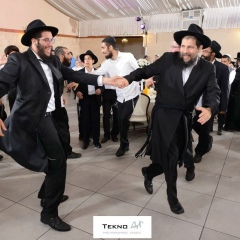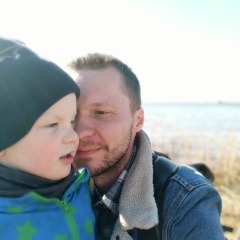В эти 9 дней до 9 Ава, когда были разрушены оба Иерусалимских Храма, Любавичский Ребе призывает , именно, в эти дни учить законы Храма.
Изучение законов Храма приближает его скорейшее восстановление!!!
Рамбам. Законы Храма (продолжение)
Глава 2
1. Жертвенник - его место точно определено, его не меняют никогда, как сказано: "Вот жертвенник для жертвы всесожжения для (народа) Израиля. и в храме был принесен на жертвенник наш праотец Ицхак, как сказано: " Иди себе в землю Мория". И, сказанно в Диврей аямим: " и начал (царь) Шломо строить дом для Б-га в Иерусалиме на горе Мория, там, где Он открылся Давиду, отцу его, в месте, которое приготовил Давид в Горене Арнон Йевусея.
2. и общеизвестная традиция, что то место, на котором построил Давид и Шломо жертвенник в Горен Арона, это то самое место на котором построил Авраам жертвенник, и принес на жертвенник своего сына Ицхака, это то место на котором строил Ной Когда вышел из ковчега. это тот жертвенник на котором принесли жертвы Каин и Авель, и на нём же приносил жертву первый человек Адам, когда был сотворён, и,именно, из этого места он был сотворён. Сказали мудрецы: " человек из места своего искупления сотворён"
3. Размеры жертвенника очень точные. Его форма известна по традиции переданный от человека к человеку. Жертвенник ,который построили евреи, вернувшиеся из Вавилона, был похож на жертвенник который будет построен в будущем. И, как нельзя прибавлять к размерам жертвенника, так и нельзя уменьшать их.
4. Три пророка возвратились с ними из изгнания (Хагай, Захария и Малахия: один свидетельствовал о месте жертвенника, другой свидетельствовал о его размерах, и третий свидетельствовал о том, что на этом жертвеннике приносят все жертвы, несмотря на то что Храм не построен.
5. жертвенник который построил Моше, и который построил Шломо, и который построили вернувшиеся из изгнания, и тот, который будет построен в будущем - все они были 10 амот (локтей) в высоту каждый. про это написано в Торе: "и три амот высота его" - Это имеется ввиду только место маараха. Жертвенник которые построили, вернувшиеся из изгнания а также тот, который будет в будущем построен, 32 локтя на 32 локтя.
6. 10 локтей высоты жертвенника - имеется в виду , как ама ( локоть) состоящий из пяти тфахим (ладоней), так и локотя, состоящий из 6 ладоней. все остальные локти здания считаются из амы состоящий из 6 тфахим. и высота всего жертвенника 58 тефахов. (имеется в виду: высота жертвенника 10 амот, из них - 2 амы оснавания и углов жертвенника, которые из амы , состоящей из 5 тефаха, всего - 10 тфахим. И, 8 амот, которые из амы , состоящей из 6 тефахов.это 48 тефахов. Итого: - 58 тефахов.)
7. И вот размеры и форма жертвенника: 5 тефахов (ладоней)вверх и 5 тефахов горизонтально к центру – это основание. Размер оставшейся площади - 30 амот (локтей) и 2 тефаха на 30 локтей и 2 тефаха [=182 X 182 тефаха]. 30 тефахов вверх и 5 тефахов горизонтально к центру – это средняя «окружающая» часть жертвенника. 18 тефахов вверх – это верхняя часть, на которой горит огонь. Общая площадь этой части - 28 локтей и 4 тефаха на 28 локтей и 4 тефаха (172 X172 тефахов) И территория, отведенная для рогов (верхних выступов), шириной в ама.
8. Высота каждого керена (угла) жертвенника 5 тефахов (ладоней), они должны быть квадратные, каждый - локоть на локоть, и, четыре рога были полые внутри, и высота места маарахи 18 ладоней. Получается: всего половина высоты жертвенника 29 ладоней от конца совева и ниже.
9. И нить "Сикра" (красного цвета) опоясывала жертвенник посередине ( около 6 ладоней от конца совева и ниже) , чтобы разделить между верхней кровью и нижней. Получается, что то высота от земли до места Маарахи девять амот (локтей) минус один тефахов ( ладонь).
10. Исод (основание) жертвенника не окружала его с четырёх сторон, как "совева" , однако, основание было протянуто наротив всей стороны северной и западной, и заканчивалось на южной локоть на локоть, а на восточной - один локоть. А на юго-восточном керене (углу) не было исода ( основания).
11. А на юго-западном керене (углу) были две дырочки, похожие на две нити. Они называются "Шитин" кровь (жертв) спускается по ним и смешивается в этом углу (локоть) и выходит в ручей Кедрон.
12. а внизу в полу в том же углу было места локоть на локоть и там находилась мраморная табличка, и было прикреплено кольцо, по которому спускались в Шитин и чистили их.
13.И "Кевеш" (пологий подъем) был построен в южной стороне жертвенника, Его длина 32 локтя, ширина - 16 локтей, и он заканчивался на земле -32 локтя от жертвенника. И отходил от него ама (локоть) на исод (основание), и ама на совеве. И небольшой просвет разделял между Кивеш и жертвенником, чтобы дать возможность кидать органы животных. И высота кевеша 9 локтей, минус тефах (ладонь) до напротив маарахи.
14. И два маленьких кевеша (подъема) выходят от него, и поворачивают в сторону исода (основания) и совева. И чуть чуть отделялись от жертвенника. И окно было с западной стороны кевеша локоть на локоть, оно называлось "рвува" , потому что в него клали негодные остатки греховной жертвы пт?6?
Изучение законов Храма приближает его скорейшее восстановление!!!
Рамбам. Законы Храма (продолжение)
Глава 2
1. Жертвенник - его место точно определено, его не меняют никогда, как сказано: "Вот жертвенник для жертвы всесожжения для (народа) Израиля. и в храме был принесен на жертвенник наш праотец Ицхак, как сказано: " Иди себе в землю Мория". И, сказанно в Диврей аямим: " и начал (царь) Шломо строить дом для Б-га в Иерусалиме на горе Мория, там, где Он открылся Давиду, отцу его, в месте, которое приготовил Давид в Горене Арнон Йевусея.
2. и общеизвестная традиция, что то место, на котором построил Давид и Шломо жертвенник в Горен Арона, это то самое место на котором построил Авраам жертвенник, и принес на жертвенник своего сына Ицхака, это то место на котором строил Ной Когда вышел из ковчега. это тот жертвенник на котором принесли жертвы Каин и Авель, и на нём же приносил жертву первый человек Адам, когда был сотворён, и,именно, из этого места он был сотворён. Сказали мудрецы: " человек из места своего искупления сотворён"
3. Размеры жертвенника очень точные. Его форма известна по традиции переданный от человека к человеку. Жертвенник ,который построили евреи, вернувшиеся из Вавилона, был похож на жертвенник который будет построен в будущем. И, как нельзя прибавлять к размерам жертвенника, так и нельзя уменьшать их.
4. Три пророка возвратились с ними из изгнания (Хагай, Захария и Малахия: один свидетельствовал о месте жертвенника, другой свидетельствовал о его размерах, и третий свидетельствовал о том, что на этом жертвеннике приносят все жертвы, несмотря на то что Храм не построен.
5. жертвенник который построил Моше, и который построил Шломо, и который построили вернувшиеся из изгнания, и тот, который будет построен в будущем - все они были 10 амот (локтей) в высоту каждый. про это написано в Торе: "и три амот высота его" - Это имеется ввиду только место маараха. Жертвенник которые построили, вернувшиеся из изгнания а также тот, который будет в будущем построен, 32 локтя на 32 локтя.
6. 10 локтей высоты жертвенника - имеется в виду , как ама ( локоть) состоящий из пяти тфахим (ладоней), так и локотя, состоящий из 6 ладоней. все остальные локти здания считаются из амы состоящий из 6 тфахим. и высота всего жертвенника 58 тефахов. (имеется в виду: высота жертвенника 10 амот, из них - 2 амы оснавания и углов жертвенника, которые из амы , состоящей из 5 тефаха, всего - 10 тфахим. И, 8 амот, которые из амы , состоящей из 6 тефахов.это 48 тефахов. Итого: - 58 тефахов.)
7. И вот размеры и форма жертвенника: 5 тефахов (ладоней)вверх и 5 тефахов горизонтально к центру – это основание. Размер оставшейся площади - 30 амот (локтей) и 2 тефаха на 30 локтей и 2 тефаха [=182 X 182 тефаха]. 30 тефахов вверх и 5 тефахов горизонтально к центру – это средняя «окружающая» часть жертвенника. 18 тефахов вверх – это верхняя часть, на которой горит огонь. Общая площадь этой части - 28 локтей и 4 тефаха на 28 локтей и 4 тефаха (172 X172 тефахов) И территория, отведенная для рогов (верхних выступов), шириной в ама.
8. Высота каждого керена (угла) жертвенника 5 тефахов (ладоней), они должны быть квадратные, каждый - локоть на локоть, и, четыре рога были полые внутри, и высота места маарахи 18 ладоней. Получается: всего половина высоты жертвенника 29 ладоней от конца совева и ниже.
9. И нить "Сикра" (красного цвета) опоясывала жертвенник посередине ( около 6 ладоней от конца совева и ниже) , чтобы разделить между верхней кровью и нижней. Получается, что то высота от земли до места Маарахи девять амот (локтей) минус один тефахов ( ладонь).
10. Исод (основание) жертвенника не окружала его с четырёх сторон, как "совева" , однако, основание было протянуто наротив всей стороны северной и западной, и заканчивалось на южной локоть на локоть, а на восточной - один локоть. А на юго-восточном керене (углу) не было исода ( основания).
11. А на юго-западном керене (углу) были две дырочки, похожие на две нити. Они называются "Шитин" кровь (жертв) спускается по ним и смешивается в этом углу (локоть) и выходит в ручей Кедрон.
12. а внизу в полу в том же углу было места локоть на локоть и там находилась мраморная табличка, и было прикреплено кольцо, по которому спускались в Шитин и чистили их.
13.И "Кевеш" (пологий подъем) был построен в южной стороне жертвенника, Его длина 32 локтя, ширина - 16 локтей, и он заканчивался на земле -32 локтя от жертвенника. И отходил от него ама (локоть) на исод (основание), и ама на совеве. И небольшой просвет разделял между Кивеш и жертвенником, чтобы дать возможность кидать органы животных. И высота кевеша 9 локтей, минус тефах (ладонь) до напротив маарахи.
14. И два маленьких кевеша (подъема) выходят от него, и поворачивают в сторону исода (основания) и совева. И чуть чуть отделялись от жертвенника. И окно было с западной стороны кевеша локоть на локоть, оно называлось "рвува" , потому что в него клали негодные остатки греховной жертвы пт?6?
In these 9 days until 9 Av, when both Jerusalem Temples were destroyed, the Lubavitcher Rebbe calls, precisely, to learn the laws of the Temple these days.
Studying the laws of the Temple brings its speedy restoration closer !!!
Rambam. Temple Laws (continued)
Chapter 2
1. The altar - its place is precisely defined, it will never be changed, as it is said: “Here is the altar for the burnt offering for the (people) of Israel. And in the temple our forefather Yitzhak was brought to the altar, as it is said:“ Go unto yourself in the land of Moriah ” . And, it is said in Divrei Ayamim: "and (the king) Shlomo began to build a house for Gd in Jerusalem on Mount Moriah, where He was revealed to David his father, in the place that David had prepared in Goren Arnon Yevuseya.
2. and the well-known tradition that the place on which David and Shlomo built the altar in Goren Arona, this is the place on which Abraham built the altar, and brought to the altar his son Isaac, this is the place on which Noah built When he left the ark . this is the altar on which Cain and Abel made sacrifices, and on it the first man Adam sacrificed when he was created, and, precisely, from this place he was created. The wise men said: “man is created from the place of his redemption”
3. The dimensions of the altar are very accurate. Its form is known by tradition transmitted from person to person. The altar, which was built by the Jews who returned from Babylon, was like the altar that will be built in the future. And just as it is impossible to add to the size of the altar, so it is impossible to reduce them.
4. Three prophets returned from exile with them (Hagai, Zechariah and Malachi: one testified to the place of the altar, the other testified to its size, and the third testified that all sacrifices were made on this altar, despite the fact that the Temple was not built.
5. the altar that Moshe built, and who built Shlomo, and who built those who returned from exile, and the one that will be built in the future - all of them were 10 amots (cubits) in height each. about this it is written in the Torah: “and its three amots its height” - This means only the place of the Maaraha. The altar that was built, those who returned from exile as well as the one that will be built in the future, is 32 cubits by 32 cubits.
6. 10 cubits of altar height - this refers to both ama (elbow) consisting of five tfahim (palms) and elbow consisting of 6 palms. all other elbows of the building are considered from Ama consisting of 6 tefahim. and the height of the whole altar is 58 tefahs. (meaning: the height of the altar is 10 amot, of which 2 amas of equipment and corners of the altar, which are from ama consisting of 5 tefahs, total - 10 tefahim. And, 8 amot, which are from ama consisting of 6 tefahs. these are 48 tefahs. Total: - 58 tefahs.)
7. And here is the size and shape of the altar: 5 tefahs (palms) up and 5 tefahs horizontally to the center - this is the foundation. The size of the remaining area is 30 amot (cubits) and 2 tefahs for 30 cubits and 2 tefahs [= 182 X 182 tefahs]. 30 tefahs up and 5 tefahs horizontally to the center - this is the middle "surrounding" part of the altar. 18 tefahs up - this is the upper part on which the fire burns. The total area of this part is 28 cubits and 4 tefahs for 28 cubits and 4 tefahs (172 X172 tefahs) and the territory allotted for horns (upper ledges) is ama wide.
8. The height of each core (corner) of the altar is 5 tefahs (palms), they should be square, each should be an elbow on the elbow, and four horns were hollow inside, and the height of the place of the maraha was 18 palms. It turns out: only half the height of the altar is 29 palms from the end of the sove and below.
9. And the Sikra thread (red) encircled the altar in the middle (about 6 palms from the end of the sove and below) to divide between the upper blood and the lower. It turns out that the height from the earth to the place of Maaraha is nine amot (cubits) minus one tefah (palm).
10. The isod (base) of the altar did not surround it on four sides, like a “sove”, however, the base was stretched on the whole side of the north and west, and ended on the south elbow with an elbow, and on the east - one elbow. And in the southeastern Keren (corner) there was no iodine (base).
11. And on the southwestern core (corner) there were two holes that looked like two threads. They are called "Shitin" blood (of victims) descends through them and mixes in this corner (elbow) and enters the Kedron stream.
12. and below in the floor in the same corner there was a place elbow on elbow and there was a marble tablet, and a ring was attached, along which they went down to Shitin and cleaned them.
13. And “Kevesh” (gentle slope) was built on the south side of the altar, Its length is 32 cubits, its width is 16 cubits, and it ended on the earth -32 cubits from the altar. And Ama (elbow) departed from him on Isod (foundation), and Ama on the sove. And a small gap was divided between Kivesh and the altar, to give the opportunity to throw the organs of animals. And the height of the kevesh is 9 cubits, minus the tefah (palm) to the opposite of the Maaraha.
14. And two small kevesh (rise) go out from it, and turn towards isod (base) and sove. And a little bit separated from the altar. And the window was on the west side of the keves lok
Studying the laws of the Temple brings its speedy restoration closer !!!
Rambam. Temple Laws (continued)
Chapter 2
1. The altar - its place is precisely defined, it will never be changed, as it is said: “Here is the altar for the burnt offering for the (people) of Israel. And in the temple our forefather Yitzhak was brought to the altar, as it is said:“ Go unto yourself in the land of Moriah ” . And, it is said in Divrei Ayamim: "and (the king) Shlomo began to build a house for Gd in Jerusalem on Mount Moriah, where He was revealed to David his father, in the place that David had prepared in Goren Arnon Yevuseya.
2. and the well-known tradition that the place on which David and Shlomo built the altar in Goren Arona, this is the place on which Abraham built the altar, and brought to the altar his son Isaac, this is the place on which Noah built When he left the ark . this is the altar on which Cain and Abel made sacrifices, and on it the first man Adam sacrificed when he was created, and, precisely, from this place he was created. The wise men said: “man is created from the place of his redemption”
3. The dimensions of the altar are very accurate. Its form is known by tradition transmitted from person to person. The altar, which was built by the Jews who returned from Babylon, was like the altar that will be built in the future. And just as it is impossible to add to the size of the altar, so it is impossible to reduce them.
4. Three prophets returned from exile with them (Hagai, Zechariah and Malachi: one testified to the place of the altar, the other testified to its size, and the third testified that all sacrifices were made on this altar, despite the fact that the Temple was not built.
5. the altar that Moshe built, and who built Shlomo, and who built those who returned from exile, and the one that will be built in the future - all of them were 10 amots (cubits) in height each. about this it is written in the Torah: “and its three amots its height” - This means only the place of the Maaraha. The altar that was built, those who returned from exile as well as the one that will be built in the future, is 32 cubits by 32 cubits.
6. 10 cubits of altar height - this refers to both ama (elbow) consisting of five tfahim (palms) and elbow consisting of 6 palms. all other elbows of the building are considered from Ama consisting of 6 tefahim. and the height of the whole altar is 58 tefahs. (meaning: the height of the altar is 10 amot, of which 2 amas of equipment and corners of the altar, which are from ama consisting of 5 tefahs, total - 10 tefahim. And, 8 amot, which are from ama consisting of 6 tefahs. these are 48 tefahs. Total: - 58 tefahs.)
7. And here is the size and shape of the altar: 5 tefahs (palms) up and 5 tefahs horizontally to the center - this is the foundation. The size of the remaining area is 30 amot (cubits) and 2 tefahs for 30 cubits and 2 tefahs [= 182 X 182 tefahs]. 30 tefahs up and 5 tefahs horizontally to the center - this is the middle "surrounding" part of the altar. 18 tefahs up - this is the upper part on which the fire burns. The total area of this part is 28 cubits and 4 tefahs for 28 cubits and 4 tefahs (172 X172 tefahs) and the territory allotted for horns (upper ledges) is ama wide.
8. The height of each core (corner) of the altar is 5 tefahs (palms), they should be square, each should be an elbow on the elbow, and four horns were hollow inside, and the height of the place of the maraha was 18 palms. It turns out: only half the height of the altar is 29 palms from the end of the sove and below.
9. And the Sikra thread (red) encircled the altar in the middle (about 6 palms from the end of the sove and below) to divide between the upper blood and the lower. It turns out that the height from the earth to the place of Maaraha is nine amot (cubits) minus one tefah (palm).
10. The isod (base) of the altar did not surround it on four sides, like a “sove”, however, the base was stretched on the whole side of the north and west, and ended on the south elbow with an elbow, and on the east - one elbow. And in the southeastern Keren (corner) there was no iodine (base).
11. And on the southwestern core (corner) there were two holes that looked like two threads. They are called "Shitin" blood (of victims) descends through them and mixes in this corner (elbow) and enters the Kedron stream.
12. and below in the floor in the same corner there was a place elbow on elbow and there was a marble tablet, and a ring was attached, along which they went down to Shitin and cleaned them.
13. And “Kevesh” (gentle slope) was built on the south side of the altar, Its length is 32 cubits, its width is 16 cubits, and it ended on the earth -32 cubits from the altar. And Ama (elbow) departed from him on Isod (foundation), and Ama on the sove. And a small gap was divided between Kivesh and the altar, to give the opportunity to throw the organs of animals. And the height of the kevesh is 9 cubits, minus the tefah (palm) to the opposite of the Maaraha.
14. And two small kevesh (rise) go out from it, and turn towards isod (base) and sove. And a little bit separated from the altar. And the window was on the west side of the keves lok

У записи 15 лайков,
3 репостов,
607 просмотров.
3 репостов,
607 просмотров.
Эту запись оставил(а) на своей стене Хаим Толочинский



































